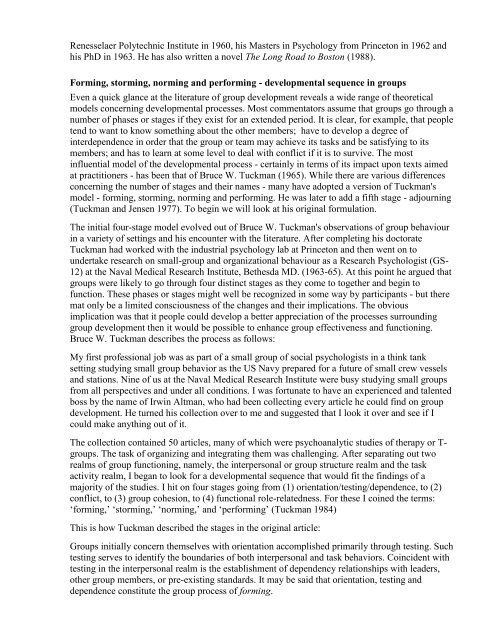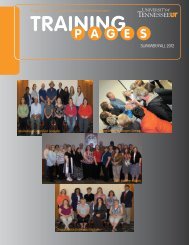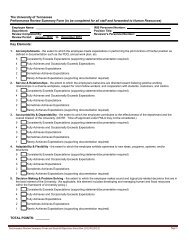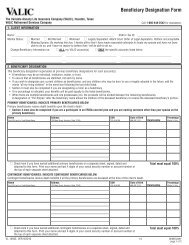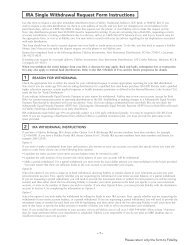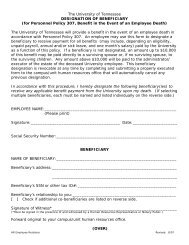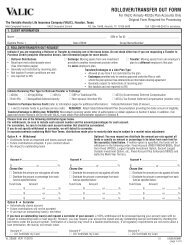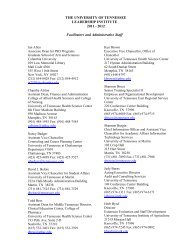bruce w. tuckman - forming, storming norming and performing in ...
bruce w. tuckman - forming, storming norming and performing in ...
bruce w. tuckman - forming, storming norming and performing in ...
Create successful ePaper yourself
Turn your PDF publications into a flip-book with our unique Google optimized e-Paper software.
Renesselaer Polytechnic Institute <strong>in</strong> 1960, his Masters <strong>in</strong> Psychology from Pr<strong>in</strong>ceton <strong>in</strong> 1962 <strong>and</strong><br />
his PhD <strong>in</strong> 1963. He has also written a novel The Long Road to Boston (1988).<br />
Form<strong>in</strong>g, <strong>storm<strong>in</strong>g</strong>, <strong>norm<strong>in</strong>g</strong> <strong>and</strong> per<strong>form<strong>in</strong>g</strong> - developmental sequence <strong>in</strong> groups<br />
Even a quick glance at the literature of group development reveals a wide range of theoretical<br />
models concern<strong>in</strong>g developmental processes. Most commentators assume that groups go through a<br />
number of phases or stages if they exist for an extended period. It is clear, for example, that people<br />
tend to want to know someth<strong>in</strong>g about the other members; have to develop a degree of<br />
<strong>in</strong>terdependence <strong>in</strong> order that the group or team may achieve its tasks <strong>and</strong> be satisfy<strong>in</strong>g to its<br />
members; <strong>and</strong> has to learn at some level to deal with conflict if it is to survive. The most<br />
<strong>in</strong>fluential model of the developmental process - certa<strong>in</strong>ly <strong>in</strong> terms of its impact upon texts aimed<br />
at practitioners - has been that of Bruce W. Tuckman (1965). While there are various differences<br />
concern<strong>in</strong>g the number of stages <strong>and</strong> their names - many have adopted a version of Tuckman's<br />
model - <strong>form<strong>in</strong>g</strong>, <strong>storm<strong>in</strong>g</strong>, <strong>norm<strong>in</strong>g</strong> <strong>and</strong> per<strong>form<strong>in</strong>g</strong>. He was later to add a fifth stage - adjourn<strong>in</strong>g<br />
(Tuckman <strong>and</strong> Jensen 1977). To beg<strong>in</strong> we will look at his orig<strong>in</strong>al formulation.<br />
The <strong>in</strong>itial four-stage model evolved out of Bruce W. Tuckman's observations of group behaviour<br />
<strong>in</strong> a variety of sett<strong>in</strong>gs <strong>and</strong> his encounter with the literature. After complet<strong>in</strong>g his doctorate<br />
Tuckman had worked with the <strong>in</strong>dustrial psychology lab at Pr<strong>in</strong>ceton <strong>and</strong> then went on to<br />
undertake research on small-group <strong>and</strong> organizational behaviour as a Research Psychologist (GS-<br />
12) at the Naval Medical Research Institute, Bethesda MD. (1963-65). At this po<strong>in</strong>t he argued that<br />
groups were likely to go through four dist<strong>in</strong>ct stages as they come to together <strong>and</strong> beg<strong>in</strong> to<br />
function. These phases or stages might well be recognized <strong>in</strong> some way by participants - but there<br />
mat only be a limited consciousness of the changes <strong>and</strong> their implications. The obvious<br />
implication was that it people could develop a better appreciation of the processes surround<strong>in</strong>g<br />
group development then it would be possible to enhance group effectiveness <strong>and</strong> function<strong>in</strong>g.<br />
Bruce W. Tuckman describes the process as follows:<br />
My first professional job was as part of a small group of social psychologists <strong>in</strong> a th<strong>in</strong>k tank<br />
sett<strong>in</strong>g study<strong>in</strong>g small group behavior as the US Navy prepared for a future of small crew vessels<br />
<strong>and</strong> stations. N<strong>in</strong>e of us at the Naval Medical Research Institute were busy study<strong>in</strong>g small groups<br />
from all perspectives <strong>and</strong> under all conditions. I was fortunate to have an experienced <strong>and</strong> talented<br />
boss by the name of Irw<strong>in</strong> Altman, who had been collect<strong>in</strong>g every article he could f<strong>in</strong>d on group<br />
development. He turned his collection over to me <strong>and</strong> suggested that I look it over <strong>and</strong> see if I<br />
could make anyth<strong>in</strong>g out of it.<br />
The collection conta<strong>in</strong>ed 50 articles, many of which were psychoanalytic studies of therapy or T-<br />
groups. The task of organiz<strong>in</strong>g <strong>and</strong> <strong>in</strong>tegrat<strong>in</strong>g them was challeng<strong>in</strong>g. After separat<strong>in</strong>g out two<br />
realms of group function<strong>in</strong>g, namely, the <strong>in</strong>terpersonal or group structure realm <strong>and</strong> the task<br />
activity realm, I began to look for a developmental sequence that would fit the f<strong>in</strong>d<strong>in</strong>gs of a<br />
majority of the studies. I hit on four stages go<strong>in</strong>g from (1) orientation/test<strong>in</strong>g/dependence, to (2)<br />
conflict, to (3) group cohesion, to (4) functional role-relatedness. For these I co<strong>in</strong>ed the terms:<br />
‘<strong>form<strong>in</strong>g</strong>,’ ‘<strong>storm<strong>in</strong>g</strong>,’ ‘<strong>norm<strong>in</strong>g</strong>,’ <strong>and</strong> ‘per<strong>form<strong>in</strong>g</strong>’ (Tuckman 1984)<br />
This is how Tuckman described the stages <strong>in</strong> the orig<strong>in</strong>al article:<br />
Groups <strong>in</strong>itially concern themselves with orientation accomplished primarily through test<strong>in</strong>g. Such<br />
test<strong>in</strong>g serves to identify the boundaries of both <strong>in</strong>terpersonal <strong>and</strong> task behaviors. Co<strong>in</strong>cident with<br />
test<strong>in</strong>g <strong>in</strong> the <strong>in</strong>terpersonal realm is the establishment of dependency relationships with leaders,<br />
other group members, or pre-exist<strong>in</strong>g st<strong>and</strong>ards. It may be said that orientation, test<strong>in</strong>g <strong>and</strong><br />
dependence constitute the group process of <strong>form<strong>in</strong>g</strong>.


